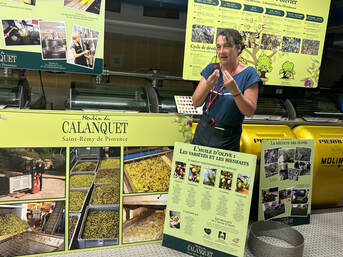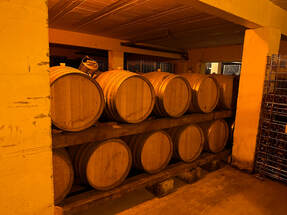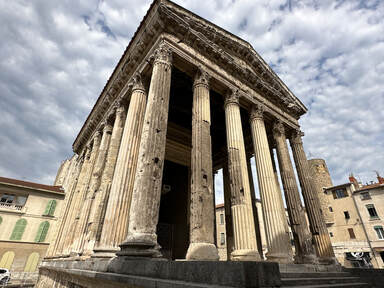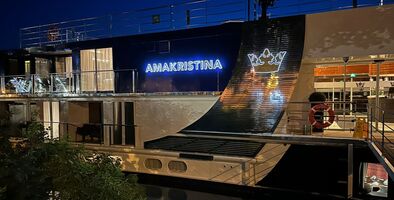Eight Days on the AmaKristina Sailing the Rhone River
 Credit: AmaWaterways Credit: AmaWaterways
By GERRY BARKER
North Palm Beach Life After four magical days in Paris, it was time to get to the Gare de Lyon station and board the train to Arles (pronounced “aarlz”), the city in the south of France where we would begin our eight-day cruise on the Rhone River aboard the AmaKristina. While we had a smooth ride on the high-speed, TGV trains that crisscross Europe, we did have to make two changes, with only a short window to make our connection — no small task when you are wrestling two large suitcases and four carry-ons. So when we did arrive at Arles, we happily paid for a taxi to take us the short distance from the station to the ship. As the ship’s personnel greeted us, they took charge of our luggage and welcomed us aboard with a glass of champagne in the Lounge. At last, we could exhale and relax. READ MORE. |
All Photos/Video by Gerry Barker
|
 Arles tour guide
Arles tour guide
Arles
We are in Arles, France, where our 8-day “Colors of Provence” wine cruise on the AmaKristina begins. Included in our AmaWaterways cruise are daily excursions, tailored from “:gentle,” “regular” or “active” for their guests. In many cases, our ship is parked near the heart of the Rhone River cities we’ll visit. All we have to do is grab a free container of water and step off the ship. It’s just one of the many reasons European river cruising is such a good value.
Arles (pronounced “aarlz” — I couldn’t never master the hard “r”), a coastal town in the South of France, is geographically the largest city in France — seven times the size of Paris, but with a population of only 50,000. It has a long history, dating back to 800 BC, and become a key city of the Roman Empire in 123 BC. But much of its fame today is tied to artist Vincent Van Gogh, who lived here in 1888-1889 — two of the most prolific and eventful years of his life. READ MORE.
We are in Arles, France, where our 8-day “Colors of Provence” wine cruise on the AmaKristina begins. Included in our AmaWaterways cruise are daily excursions, tailored from “:gentle,” “regular” or “active” for their guests. In many cases, our ship is parked near the heart of the Rhone River cities we’ll visit. All we have to do is grab a free container of water and step off the ship. It’s just one of the many reasons European river cruising is such a good value.
Arles (pronounced “aarlz” — I couldn’t never master the hard “r”), a coastal town in the South of France, is geographically the largest city in France — seven times the size of Paris, but with a population of only 50,000. It has a long history, dating back to 800 BC, and become a key city of the Roman Empire in 123 BC. But much of its fame today is tied to artist Vincent Van Gogh, who lived here in 1888-1889 — two of the most prolific and eventful years of his life. READ MORE.

Les Baux-de-Provence
It's Day Two of our Rhone River wine cruise on AmaWaterways' AmaKristina ship. Today, Pam and i have signed up for two excursions -- both included with our fare. In the morning, we took the "Van Gogh Walking Tour," following in the footsteps of famed artist Vincent Van Gogh, who lived here in 1888-89. You can read more about it HERE.
In the afternoon, we boarded a bus for a trip to nearby Les Baux-de-Provence, and afterwards, a visit to an olive farm. Les Baux-de-Provence, perched on a rocky outcrop in the Alpilles mountains, has been called one of the most beautiful villages in all of France. Here, built around the ruins of medieval castle, a geologist discovered aluminum ore and named it bauxite, after the village's name.
Our tour includes lots of free time to explore the village and discover its many charms.
READ MORE.
It's Day Two of our Rhone River wine cruise on AmaWaterways' AmaKristina ship. Today, Pam and i have signed up for two excursions -- both included with our fare. In the morning, we took the "Van Gogh Walking Tour," following in the footsteps of famed artist Vincent Van Gogh, who lived here in 1888-89. You can read more about it HERE.
In the afternoon, we boarded a bus for a trip to nearby Les Baux-de-Provence, and afterwards, a visit to an olive farm. Les Baux-de-Provence, perched on a rocky outcrop in the Alpilles mountains, has been called one of the most beautiful villages in all of France. Here, built around the ruins of medieval castle, a geologist discovered aluminum ore and named it bauxite, after the village's name.
Our tour includes lots of free time to explore the village and discover its many charms.
READ MORE.

The Olive Farm
After leaving the village, we make the short bus ride to St. Remy and one of the olive farms -- Le Moulin du Calanquet. While France isn't the largest olive oil producer, the products from its 30,000 olive farmers are highly rated for its quality.
First introduced to the region by the Romans, the industry has rebounded from the killing frosts of 1956. Le Moulin du Calanquet can trace five generations of farmers, and use five varieties of olives in their products. On our tour, we were able to sample both the olives and the olive oils. We learn there's a lot that goes into making that bottle of extra virgin olive oil that sits on our kitchen counter. READ MORE.
After leaving the village, we make the short bus ride to St. Remy and one of the olive farms -- Le Moulin du Calanquet. While France isn't the largest olive oil producer, the products from its 30,000 olive farmers are highly rated for its quality.
First introduced to the region by the Romans, the industry has rebounded from the killing frosts of 1956. Le Moulin du Calanquet can trace five generations of farmers, and use five varieties of olives in their products. On our tour, we were able to sample both the olives and the olive oils. We learn there's a lot that goes into making that bottle of extra virgin olive oil that sits on our kitchen counter. READ MORE.
 Market in Avignon
Market in Avignon
A Taste of Avignon
It's Day Three of our "Colors of Provence" cruise on the AmaKristina, and we are docked at the historic city of Avignon. In actuality, we are double-docked. As is sometimes the case on the Rhone River, we are sharing docking space with another ship, the Avalon Poetry, which means we'll walk through their lobby to shore.
Avignon has a long and rich history, dating back to the Romans. In the 14th century, Pope Clement V moved the Papal seat from Rome to Avignon, and it came to be known as "The City of Popes." Here you'll find charming streets, an expansive town square and striking architecture. And don't miss the trompe l’oeil (in French it means "deceives the eye") window paintings. You might mistake them for real people. READ MORE.
It's Day Three of our "Colors of Provence" cruise on the AmaKristina, and we are docked at the historic city of Avignon. In actuality, we are double-docked. As is sometimes the case on the Rhone River, we are sharing docking space with another ship, the Avalon Poetry, which means we'll walk through their lobby to shore.
Avignon has a long and rich history, dating back to the Romans. In the 14th century, Pope Clement V moved the Papal seat from Rome to Avignon, and it came to be known as "The City of Popes." Here you'll find charming streets, an expansive town square and striking architecture. And don't miss the trompe l’oeil (in French it means "deceives the eye") window paintings. You might mistake them for real people. READ MORE.

Wine Tasting
It's Day Three of our AmaKristina cruise, and after a morning walking tour of Avignon, we are boarding a bus that will take us to the nearby Châteauneuf-du-Pape wine region in southeastern France for a wine tasting. Renowned for its wines since the Popes lived in Avignon in the 1300s, we are going to the Quiot Family winery, operated by the Quiot family since 1748.
Currently, Florence and her brother, Jean-Baptiste -- the 13th generation of the family -- manage the business, which exports wine to more than 30 countries. The entrance is marked by the tall, graceful cypress trees that are everywhere in Provence. They are symbols of good luck, hospitality and eternal life. But mostly they lend a striking feature to any landscape. But enough talk. Let's sample some wine, shall we? READ MORE.
It's Day Three of our AmaKristina cruise, and after a morning walking tour of Avignon, we are boarding a bus that will take us to the nearby Châteauneuf-du-Pape wine region in southeastern France for a wine tasting. Renowned for its wines since the Popes lived in Avignon in the 1300s, we are going to the Quiot Family winery, operated by the Quiot family since 1748.
Currently, Florence and her brother, Jean-Baptiste -- the 13th generation of the family -- manage the business, which exports wine to more than 30 countries. The entrance is marked by the tall, graceful cypress trees that are everywhere in Provence. They are symbols of good luck, hospitality and eternal life. But mostly they lend a striking feature to any landscape. But enough talk. Let's sample some wine, shall we? READ MORE.
 Emy the dog with the truffle farm owner
Emy the dog with the truffle farm owner
The Truffle Farm
In France, truffles are nothing to trifle with.
The cultivation and harvesting of these underground fungi, prized by chefs and foodies alike, is big business here. France produces around 30 tons a year, and much of that production in is the southeastern region, where our tour bus happens to be traveling. Our river ship, the AmaKristina, is docked in Viviers (viv-je), a quaint, hilltop village where the imposing Viviers Cathedral overlooks the Rhone River below. Our destination today is the La Rabassiere truffle farm, near the town of Grignon, where we’ll get an up close and personal look at truffle farming. READ MORE.
In France, truffles are nothing to trifle with.
The cultivation and harvesting of these underground fungi, prized by chefs and foodies alike, is big business here. France produces around 30 tons a year, and much of that production in is the southeastern region, where our tour bus happens to be traveling. Our river ship, the AmaKristina, is docked in Viviers (viv-je), a quaint, hilltop village where the imposing Viviers Cathedral overlooks the Rhone River below. Our destination today is the La Rabassiere truffle farm, near the town of Grignon, where we’ll get an up close and personal look at truffle farming. READ MORE.

Steam Train Ride
On Day Five of our river cruise on the AmaKristina, we are taking an "exciting and nostalgic steam train ride through the magnificent landscape carved along the Gorge du Doux" near Tournon, France. All true except for one thing: The steam engine is out of service, so we get the diesel variety. But that's okay -- the scenery is indeed magnificent.
The train boasts a lot of history. Work began in 1886, and took 1,000 workers five years to complete in 1891. The cars date from 1891, and provide an open air, panoramic look at the gorge (which, by the way, passes a nudist beach). Take a look (sorry --there are no views of the beach area): READ MORE.
On Day Five of our river cruise on the AmaKristina, we are taking an "exciting and nostalgic steam train ride through the magnificent landscape carved along the Gorge du Doux" near Tournon, France. All true except for one thing: The steam engine is out of service, so we get the diesel variety. But that's okay -- the scenery is indeed magnificent.
The train boasts a lot of history. Work began in 1886, and took 1,000 workers five years to complete in 1891. The cars date from 1891, and provide an open air, panoramic look at the gorge (which, by the way, passes a nudist beach). Take a look (sorry --there are no views of the beach area): READ MORE.

Wine and Chocolate
On Day Four of our 8-day Rhone River cruise on the AmaKristina, we spent the morning visiting a truffle farm near the town of Grignon. In the evening, we are docked at Tournon, which boasts the oldest suspension bridge in France, built in 1825. Tonight finds us at a chocolate and red wine pairing at Villa Caroube in the Cave de Tain winery. Red wine plus chocolate? Sign us up!
Located at the foot of a beautiful Hermitage hillside, it's a glorious, late summer day in Provence, with the afternoon sun reflecting off the rows of vines. On these hillside terraces, workers "embrace the traditions of tying the vines with straw, with that fine action of quickly and precisely tying 'straw knots'" that takes "years to master." READ MORE.
On Day Four of our 8-day Rhone River cruise on the AmaKristina, we spent the morning visiting a truffle farm near the town of Grignon. In the evening, we are docked at Tournon, which boasts the oldest suspension bridge in France, built in 1825. Tonight finds us at a chocolate and red wine pairing at Villa Caroube in the Cave de Tain winery. Red wine plus chocolate? Sign us up!
Located at the foot of a beautiful Hermitage hillside, it's a glorious, late summer day in Provence, with the afternoon sun reflecting off the rows of vines. On these hillside terraces, workers "embrace the traditions of tying the vines with straw, with that fine action of quickly and precisely tying 'straw knots'" that takes "years to master." READ MORE.
 The Temple of Augustus and Livia
The Temple of Augustus and Livia
Vienne
Day Six on our AmaWaterways' "Colors of Provence" river cruise finds us docked in Vienne, located between the wine regions of Beaujolais and Côtes du Rhône. Once again, the Romans and their buildings take centerstage. In fact, our tour is titled, "Footsteps of the Ancient Romans."
But before we walk, we must ride, so we start by boarding a tram that will take up winding, narrow streets to Mount Pipet, a high point that offers sweeping views of the city and river, and a bird's eye view of the well-preserved Roman amphitheater below us. The site of a one-time fortress during the Middle Ages, it now houses a statue and a chapel dedicated to Notre-Dame-de-la-Salette. READ MORE.
Day Six on our AmaWaterways' "Colors of Provence" river cruise finds us docked in Vienne, located between the wine regions of Beaujolais and Côtes du Rhône. Once again, the Romans and their buildings take centerstage. In fact, our tour is titled, "Footsteps of the Ancient Romans."
But before we walk, we must ride, so we start by boarding a tram that will take up winding, narrow streets to Mount Pipet, a high point that offers sweeping views of the city and river, and a bird's eye view of the well-preserved Roman amphitheater below us. The site of a one-time fortress during the Middle Ages, it now houses a statue and a chapel dedicated to Notre-Dame-de-la-Salette. READ MORE.

Beaujolais Wine Region
It's the last full day on our eight-day wine cruise on the AmaKristina, and our tour bus is heading for the Beaujolais wine region north of Lyon and the historic town of Oingt. Once a Roman settlement, located high on a hill, it flourished in the 13th century, and still retains much of its Medieval charm as one of the most beautiful villages in France. We are headed for the Domaine de Fond-Vieille winery, where we'll have a wine tasting and learn about the region and its grapes from the winery owner, Dominique. It's been family-owned since 1758, and he's been making wine here since 1988 from 100-year-old vines. READ MORE.
It's the last full day on our eight-day wine cruise on the AmaKristina, and our tour bus is heading for the Beaujolais wine region north of Lyon and the historic town of Oingt. Once a Roman settlement, located high on a hill, it flourished in the 13th century, and still retains much of its Medieval charm as one of the most beautiful villages in France. We are headed for the Domaine de Fond-Vieille winery, where we'll have a wine tasting and learn about the region and its grapes from the winery owner, Dominique. It's been family-owned since 1758, and he's been making wine here since 1988 from 100-year-old vines. READ MORE.
 City of Lyon
City of Lyon
Lyon
One week after our AmaWaterways' "Colors of Provence" wine cruise on the AmaKristina, we are docked in Lyon, our last port of call. Lyon is France's third-largest city, located at the confluence of the Rhône and Saône Rivers. Like many cities we have visited on this cruise, it has a long and rich history, dating back to the Romans.
We are taking a city tour, which starts to the top of the city -- literally -- and works its back through the historic Vieux Lyon (old town) and the St. Jean district. Our starting point is Fourviere Hill, from which you can get a panoiramic view of the city. Also here is the magnificent Basilica of Notre-Dame de Fourvière, built between 1872 and 1896 and dedicated to the Virgin Mary, whose golden statue stands high against the sky. This area is a designated UNESCO World Heritage Site. READ MORE.
One week after our AmaWaterways' "Colors of Provence" wine cruise on the AmaKristina, we are docked in Lyon, our last port of call. Lyon is France's third-largest city, located at the confluence of the Rhône and Saône Rivers. Like many cities we have visited on this cruise, it has a long and rich history, dating back to the Romans.
We are taking a city tour, which starts to the top of the city -- literally -- and works its back through the historic Vieux Lyon (old town) and the St. Jean district. Our starting point is Fourviere Hill, from which you can get a panoiramic view of the city. Also here is the magnificent Basilica of Notre-Dame de Fourvière, built between 1872 and 1896 and dedicated to the Virgin Mary, whose golden statue stands high against the sky. This area is a designated UNESCO World Heritage Site. READ MORE.
Our thanks to AmaWaterways for hosting us. Learn more at AmaWaterways.com.


